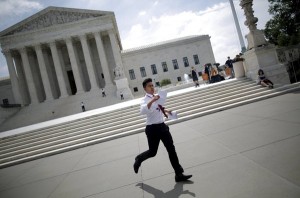Court’s Free-Speech Expansion Has Far-Reaching Consequences
< < Go Back
It is not too early to identify the sleeper case of the last Supreme Court term. In an otherwise minor decision about a municipal sign ordinance, the court in June transformed the First Amendment.
Robert Post, the dean of Yale Law School and an authority on free speech, said the decision was so bold and so sweeping that the Supreme Court could not have thought through its consequences. The decision’s logic, he said, endangered all sorts of laws, including ones that regulate misleading advertising and professional malpractice.
“Effectively,” he said, “this would roll consumer protection back to the 19th century.”
Floyd Abrams, the prominent constitutional lawyer, called the decision a blockbuster and welcomed its expansion of First Amendment rights. The ruling, he said, “provides significantly enhanced protection for free speech while requiring a second look at the constitutionality of aspects of federal and state securities laws, the federal Communications Act and many others.”
Whether viewed with disbelief, alarm or triumph, there is little question that the decision, Reed v. Town of Gilbert, marks an important shift toward treating countless laws that regulate speech with exceptional skepticism.
Though just two months old, the decision has already required lower courts to strike down laws barring panhandling, automated phone calls and “ballot selfies.”
The ordinance in the Reed case discriminated against signs announcing church services in favor of ones promoting political candidates. That distinction was so offensive and so silly that all nine justices agreed that it violated the First Amendment.
It would have been easy to strike down the ordinance under existing First Amendment principles. In a concurrence, Justice Elena Kagan said the ordinance failed even “the laugh test.”
But Justice Clarence Thomas, writing for six justices, used the occasion to announce that lots of laws are now subject to the most searching form of First Amendment review, called strict scrutiny.
Strict scrutiny requires the government to prove that the challenged law is “narrowly tailored to serve compelling state interests.” You can stare at those words as long as you like, but here is what you need to know: Strict scrutiny, like a Civil War stomach wound, is generally fatal.
“When a court applies strict scrutiny in determining whether a law is consistent with the First Amendment,” said Mr. Abrams, who has represented The New York Times, “only the rarest statute survives the examination.”
Laws based on the content of speech, the Supreme Court has long held, must face such scrutiny.
The key move in Justice Thomas’s opinion was the vast expansion of what counts as content-based. The court used to say laws were content-based if they were adopted to suppress speech with which the government disagreed.
Justice Thomas took a different approach. Any law that singles out a topic for regulation, he said, discriminates based on content and is therefore presumptively unconstitutional.
Securities regulation is a topic. Drug labeling is a topic. Consumer protection is a topic.
A recent case illustrates the distinction between the old understanding of content neutrality and the new one.
Last year, the federal appeals court in Chicago upheld an ordinance barring panhandling in parts of Springfield, Ill. The ordinance was not content-based, Judge Frank H. Easterbrook wrote, because it was not concerned with the ideas panhandling conveys. “Springfield,” Judge Easterbrook wrote, “has not meddled with the marketplace of ideas.”
This month, after the Reed decision, the appeals court reversed course and struck down the ordinance.
“The majority opinion in Reed effectively abolishes any distinction between content regulation and subject-matter regulation,” Judge Easterbrook wrote. “Any law distinguishing one kind of speech from another by reference to its meaning now requires a compelling justification.”
More From The New York Times:




